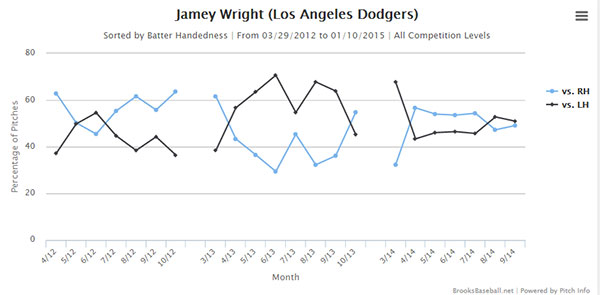| G | IP | K% | BB% | ERA | FIP | xFIP | WAR | |
| MLB | 61 | 70.1 | 17.5% | 8.8% | 4.35 | 3.47 | 3.80 | 0.1 |
What Happened In 2014: Got into 61 games, and yet you don’t remember a single one, do you?
Last December, we heard that Jamey Wright was deciding between the Rays and the Dodgers, and despite the fact that he was turning 39, I didn’t mind at all. Here’s me from a few weeks before he signed:
Again, guys in their late-30s who don’t throw hard and bounce to new teams every year as NRIs are far from flashy. But Wright somehow keeps improving. I mean, his K/9 went from 4.36 (!) in 2010 with Cleveland and Seattle to 6.32 in 2011 with Seattle to 7.18 in 2012 with the Dodgers to 8.36 in 2013 with Tampa…. and he dropped his BB/9 below three for the first time ever last year. His FIP marks the last two years have been 3.39 and 3.13; his ERA the last three years is 3.32.
He’s not throwing harder; if anything, he’s throwing softer than ever. What he’s done is nearly entirely ditch his traditional fastball in favor of a cutter, and incorporating a changeup that he rarely used before.
…and at FanGraphs, after he signed, I looked into his interesting reverse platoon splits:
Wright’s 25.4% strikeout percentage against lefties was a top 20 mark in the majors, just behind Jose Fernandez and just ahead of Felix Hernandez — great company to keep. When the Rays needed a bullpen game against a lefty-heavy Oakland lineup in September, it was Wright who got the call for his first start since 2007.
Really, this is exactly the kind of thing the Rays excel in — find an undervalued asset, identify something nontraditional that he’s good at, and take advantage of it. For Wright, it’s earned him a guaranteed contract for the first time in years. Now we’ll just need to see if the Dodgers keep the trend going, or if age will finally catch up to Wright.
Once the season got going, we really didn’t talk about Wright all that much, which is probably the best thing a 39-year-old reliever in the midst of an imploding bullpen can hope for. Whether it was because he was rarely good or awful, or because we were more focused on Brian Wilson and friends than anything else, Wright got relatively little press around here.
For the first few months, that was fine. In Wright’s first 34 games and 41 innings (through July 5, and you’ll understand the arbitrary endpoint in a second), he allowed a line of only .219/.293/.295 to go with a 2.41 ERA and a 3.62 FIP, numbers that were absolutely more than acceptable for the contract he’d received. But he allowed eight runs over his next three games — just that pushed his ERA from 2.41 to 3.74, which is a great example of why ERA for relievers is tough to rely upon — and his second half started to get a little rough. After a .280 wOBA against in the first half, it was .340 in the second.
Of course, Wright’s K% went up in the second half (16.3% to 19.4%) while his BB% went down (9.8% to 7.3%), and a crazy BABIP spike from .271 to .379 certainly played a bit of a role in that. Still, Brim noted Wright’s continued effectiveness against lefties in September…
Wright’s strikeout rate is consistently higher against lefties than it is against right-handed batters. Mike noted Wright’s overall upward trend in strikeout rate before the season, but that has not really maintained this year, down against both types of batter. Still, Wright is getting better results against lefties this season, as well as every other year listed on the table. FIP can be pretty fickle in tiny samples like reliever platoon splits due to HR/FB luck getting pooled, but in four of the five seasons listed (including 2014), Wright’s FIP is indeed better against lefties. wOBA can also be finicky and doesn’t account for things like control of the running game, but like FIP it is better than lefties in every season listed other than 2013.
…but he also noted that the Dodgers hadn’t actually been using him in that way, as opposed to what the Rays had done. Here’s an updated version of the chart Daniel had used, to include the full 2014 season:
So while we all got a kick in September out of Wright being an emergency starter for the second year in a row after not having previously started since 2007, ultimately he was more or less a replacement or slightly-above reliever. For the minimal financial outlay, and considering all of the other bullpen issues, it was still a signing worth making. That said, it says a lot to how much depth has improved already that it’s difficult if not impossible to see him being worthy of a spot in the 2015 bullpen.
2015 status: Wright is a free agent, and will likely need to find yet another minor league deal somewhere if he wants to continue his career. A third go-round with the Dodgers seems unlikely.
 Dodgers Digest Los Angeles Dodgers Baseball Blog
Dodgers Digest Los Angeles Dodgers Baseball Blog
